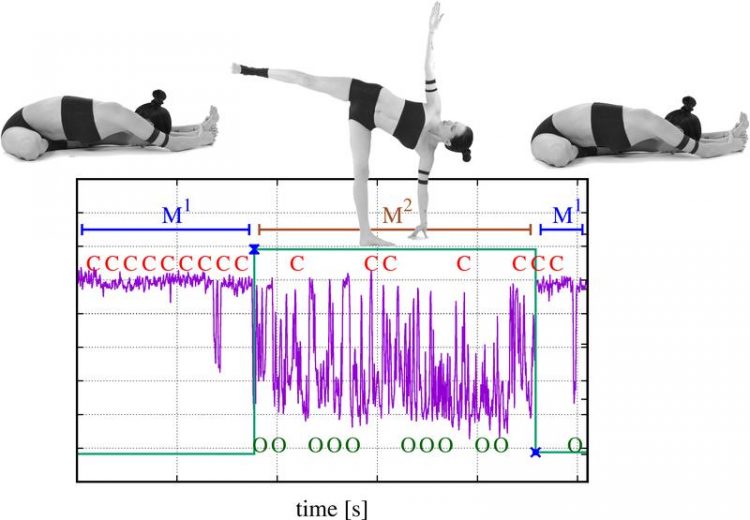The yoga poses of ion channels

Closed - open - closed: The different activity levels of an ion channel correspond to different yoga poses. Yoga illustrations: Kennguru, Graphics: Siekmann
Scientists from the universities of Melbourne and Göttingen have gained new insights into the complex stochastic patterns of opening and closing observed in ion channels. The key is the molecular architecture of the protein that ion channels are made of.
Proteins can rearrange their three-dimensional structure only in certain ways. By analysing a large set of time series data, the researchers were able to link the activity levels of an ion channel to the configurations of the channel protein. The study was published in the journal Proceedings of the Royal Society A.
Ion channels are tiny components of human cells that play important roles in all physiological processes occurring in the body. They form pores that allow electrically charged particles (ions) such as sodium, chloride and potassium to pass the cell membrane.
Through ion channels, nerve cells are charged like batteries, which allows them to communicate with other cells, for example, in the brain. The heartbeat is also initiated once per second by such an electrical signal. Defects or missing of certain ion channels can lead to diseases such as cystic fibrosis.
Via transforming their structure, ion channels open or close pores in the cell membrane. However, this opening and closing can be quite irregular.
“Quite often, an ion channel doesn’t seem to do anything for a long time. But then it suddenly shows its maximum level of activity before it switches off again”, explains Dr. Ivo Siekmann from Göttingen University’s Felix Bernstein Institute for Mathematical Statistics. “And in between there can be further intermediate activity levels.”
The key is the complex three-dimensional protein structure that forms the ion channel. “An ion channel can’t deform arbitrarily”, says Dr. Siekmann. “Similar to yoga, there are certain positions that work for an ion channel.” The activity levels of the ion channels correspond to different yoga poses. By combining several novel statistical and mathematical approaches, the scientists revealed how an ion channel transitions between these different yoga poses.
The study has several practical implications: Whereas designing pharmaceuticals that target ion channels has the potential to develop highly specific drugs, the results of the article indicate that only the average activity level, but not the actual opening and closing of the ion channel can be influenced.
“Switching between different activity levels provides a simpler explanation for some physiological processes”, says Dr. Siekmann. “Instead of the complicated and hectic opening and closing, they depend on the relaxed transitions between different yoga poses.”
Dr. Ivo Siekmann is a postdoc at the Felix Bernstein Institute for Mathematical Statistics (FBMS) in the Faculty of Mathematics and Computer Science at the University of Göttingen. He works in Prof. Dr. Axel Munk’s group, which develops statistical models and methods for the analysis of ion channels.
This research is funded through the DFG Collaborative Research Centre “Functionality controlled by organization in and between membranes“ and a Max Planck Fellowship at the Max Planck Institute for Biophysical Chemistry in Göttingen.
Original publication: Ivo Siekmann et al. Modelling modal gating of ion channels with hierarchical Markov models. Proceedings of the Royal Society A 2016. Doi: 10.1098/rspa.2016.0122.
Contact:
Dr. Ivo Siekmann
University of Göttingen
Faculty of Mathematics and Computer Science
Institute for Mathematical Stochastics
Goldschmidtstraße 7, 37077 Göttingen
Phone +49 551 39-172127
Email: ivo.siekmann@mathematik.uni-goettingen.de
http://www.stochastik.math.uni-goettingen.de/index.php?id=88&language=en
Media Contact
All latest news from the category: Life Sciences and Chemistry
Articles and reports from the Life Sciences and chemistry area deal with applied and basic research into modern biology, chemistry and human medicine.
Valuable information can be found on a range of life sciences fields including bacteriology, biochemistry, bionics, bioinformatics, biophysics, biotechnology, genetics, geobotany, human biology, marine biology, microbiology, molecular biology, cellular biology, zoology, bioinorganic chemistry, microchemistry and environmental chemistry.
Newest articles

First-of-its-kind study uses remote sensing to monitor plastic debris in rivers and lakes
Remote sensing creates a cost-effective solution to monitoring plastic pollution. A first-of-its-kind study from researchers at the University of Minnesota Twin Cities shows how remote sensing can help monitor and…

Laser-based artificial neuron mimics nerve cell functions at lightning speed
With a processing speed a billion times faster than nature, chip-based laser neuron could help advance AI tasks such as pattern recognition and sequence prediction. Researchers have developed a laser-based…

Optimising the processing of plastic waste
Just one look in the yellow bin reveals a colourful jumble of different types of plastic. However, the purer and more uniform plastic waste is, the easier it is to…



